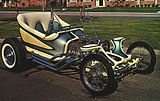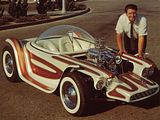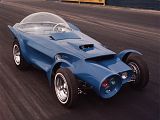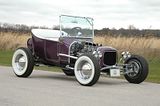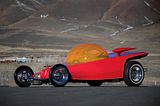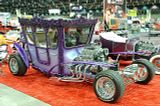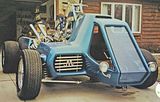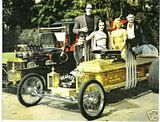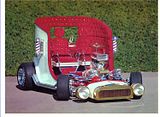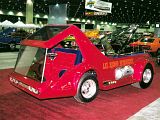Ed "Big Daddy" Roth
Ed "Big Daddy" Roth (March 4, 1932 – April 4, 2001) was an artist and cartoonist who created the hot-rod icon Rat Fink and other extreme characters. As a custom car builder, Roth was a key figure in Southern California's "Kustom Kulture"/Hot-rod movement of the 1960s. He grew up in Bell, California, attending Bell High School, where his classes unsurprisingly included auto shop and art. Roth is best known for his grotesque caricatures — typified by Rat Fink — depicting imaginative, out-sized monstrosities driving representations of the hot rods that he and his contemporaries built. Although Detroit native Stanley Mouse (Miller) is credited with creating the so-called "Monster Hot Rod" art form, Roth is certainly the individual who popularized it. Roth is less well known for his innovative work in turning hot rodding from crude backyard engineering, where performance was the bottom line, into a refined art form where aesthetics were equally important, breaking new ground with fiberglass bodywork. In the 1960s, plastic models of many of Roth's cars, as well as models of Rat Fink and other whimsical creatures created by Roth, were marketed by the Revell model company. Numerous artists were associated with Roth, including painter Robert Williams, Rat Fink Comix artist R.K. Sloane and Steve Fiorilla, who illustrated Roth's catalogs. Roth was active in the field of counterculture art and hot-rodding his entire adult life. At the time of his death in 2001, he was working on an innovative hot-rod project involving a compact car planned as a radical departure from the dominant "tuner" performance modification style. In his later years, Roth's telephone number was listed in the directory, and he encouraged fans to contact him: he was always generous with his time and enthusiasm. A Roth custom feared lost for many years was the subject of a number of articles in automotive enthusiast magazines in the summer of 2008. The Orbitron, built in 1964, was discovered in Mexico in late 2007. The car, in dilapidated, inoperative condition, had been parked for quite some time in front of an adult bookstore in Ciudad Juárez. The owners of the shop were also the owners of the car. It was purchased by Michael Lightbourn, an American auto restorer who did extensive business in Mexico and who in turn repatriated the car to the United States. The Orbitron has since been restored to its original condition by present owner Beau Boeckmann. Ed Roth was member of the Drag Wagons car club of Maywood, California. Show Cars
Mr. Gasser & the WeirdosMr. Gasser & the Weirdos was a 1960s novelty group led by Roth, who himself was known as Mr. Gasser. Formed in the early 1960s, they released a few bizarre surf rock albums, most notably 1963's Hot Rod Hootenanny. One Way Records released a 2CD-set (S22-18319) which contains the 3 LPs and the original artwork. Personal lifeEd Roth was reportedly married three times. His third wife, Ilene, lives in Manti, Utah, where Ed Roth spent the final years of his life. Roth joined The Church of Jesus Christ of Latter-day Saints (Mormons) in 1974. Since his death, an annual “Big Daddy Roth” Open House has been held in Manti around the anniversary of his death. The museum that Ilene Roth created to honor her late husband includes displays of Ed's art work and other memorabilia. It is open to the public during the open house and year-round by appointment. Ed Roth: the Car Customization King of the 1960sThe 1960s (or, if you prefer, The Sixties) were known for a lot of things, but they were mainly famous for the start of the “sex, drugs and rock'n'roll” period. It was an era of reckless excess and flashiness, the emergence of libertine and “free” attitudes, as well as counter-culture. Of course, many people still think of The Sixties as of an era full o depravation and drug abuse. Proof of this are Paul Kantner's (from Jefferson Airplane) words: “If you can remember anything about the sixties, you weren't really there.” The special feature about his style of drawing were the way he embedded both the cute and the grotesque in the same project. At the end of the fifties he left the “Crazy Painters” and opened his own “Roth Studios” in Maywood, a suburb of the “city of angels”. With his own business on the roll, he spent the next decade transforming the way car customization happened, partly thanks to the development of fiberglass, which had the great feature of being easily molded into the most extreme shapes. So it happened that Roth, together with other talented artists like Robert Williams, Dave Mann and of course Von Dutch became the greatest promoters of Kustom Kulture in the 1960s. Becoming his main line of business, the t-shirt company was actually only used to finance his first true passion, which still consisted of his now famous weird-shaped cars. He based a lot of his skills by laying the somewhat newly discovered fiberglass over hand-carved plaster forms, thus sculpting the unique custom bodies in almost any shape possible. One of his greatest four-wheeled creations was revealed in 1959, when he created a car almost entirely from the ground up. His fame also reached big companies like Revell, who started producing miniature kit replicas of Roth custom vehicles, for which he also licensed his name. When the guys at Revell suggested that he needed a catchier name, he added the “Big Daddy” nickname to his moniker. Retrieved from; autoevolution 10th of December 2008 Alex Oagana
References
External links |
  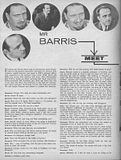 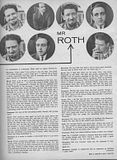 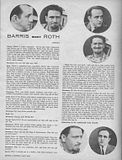 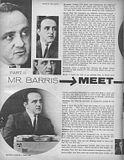  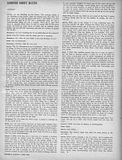 |
||||||||||||||||||||||||||||||||||||||||||||||||||||||||||||||||




